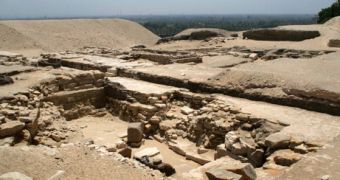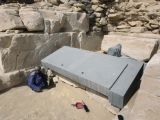The "Headless Pyramid", or Number 29 as it was previously known as, stands today only as the foundation of the ancient structure. It was first discovered in the middle of the 19th century, by Karl Richard Lepsius, a German archaeologist, but the sands of Saqqara buried it, its location being lost. Yesterday, archaeologists announced that they have again discovered the 'lost' pyramid currently believed to have belonged to King Menkauhor of Egypt's 5th dynasty of pharaohs, said to have ruled for only eight years in the middle 2400 B.C.
"After Lepsius the location of the pyramid was lost and the substructure of the pyramid never known. It was forgotten by people until we began to search this area and a hill of sand, maybe 7.6 meters high", said Zahi Hawass, secretary general of Egypt's Supreme Council of Antiquities.
The structure does not seem to bear any markings that would specifically state the name of its owner, which is not surprising considering that it was mostly reduced to its foundation. The pyramid however lacks the winding maze features typical to the Middle Kingdom temple, while the artwork and inscriptions, as well as the red granite blocks the structure was built from are characteristic to the Old Kingdom.
Additionally, the lid of the sarcophagus was made of gray schist, also typical to the Old Kingdom. Another pointer that could indicate towards the possible owner of the burial place is a pyramid next to it recently found and identified as that of King Teti of the 6th dynasty, who ruled between 2345 and 2181 B.C. "There were missing pyramids of the kings, and this is one of them", said Hawass.
Another discovery reported by archaeologists is that of some new parts of a sacred road built about 2,000 years after the Old Kingdom, showing that Saqqara, located in the ancient capital of Memphis, was extremely important throughout the ancient history of Egypt.
"During the whole history of Egypt, Memphis and Saqqara had remained very, very important. I am discovering tombs of people of the 26th dynasty [in Saqqara] that were reusing tombs of the 19th dynasty. It is a sacred place, and so many important people wanted to be buried there", said Ola El Aguizy, professor of ancient Egyptian languages at Cairo University.
According to Aguizy, the ancient sacred road in Saqqara was used for the procession of mummified bulls of the god of the dead, Osiris, which explains why people wanted to be buried there. "Osiris was enthroned like a king and when he died they made funerals like those of a king", El Aguizy said.
The road was allegedly discovered in 1850 by the French archaeologist Auguste Mariette who named it the Way of the Sphinxes due to the long row of statues usually found at the entrances of Egyptian temples.
"The modern name of ancient Memphis is Mit Rahina which means the way of the Sphinx. So this path is presumably the Way, with sphinxes formerly on the two sides.", El Aguizy said.
Hopefully, the sacred road of Saqqara will point towards other temples in the surrounding area, but first the workers from the village near the Menkauhor site will need to be relocated.
"When I say we've discovered 30 percent of the Egyptian monuments, I take Saqarra as the first example. Saqqara is a virgin site. It's very important for us to do this excavation to understand more about the pyramids of the Old Kingdom", Hawass said.

 14 DAY TRIAL //
14 DAY TRIAL // 
